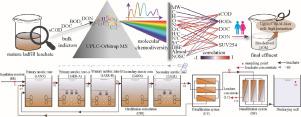Water Research ( IF 11.4 ) Pub Date : 2021-03-03 , DOI: 10.1016/j.watres.2021.117000 Liming Shao , Yingtao Deng , Junjie Qiu , Hua Zhang , Wanying Liu , Kristina Bazienė , Fan Lü , Pinjing He

|
Mature landfill leachate contains a substantial fraction of recalcitrant dissolved organic matters (DOM) that is a challenging for conventional wastewater treatment that is typically focused on the removal of biodegradable organic matter. “Biological treatment + membrane treatment” has been widely employed to treat complex leachate. However, the performance of each unit based on both conventional bulk indicators and molecular information has not been well understood. Therefore, the fate of DOM chemodiversity along the full-scale treatment process across ten sampling points over three different seasons were analyzed to determine the efficiency of every unit process with the assistance of ultra-performance liquid chromatography coupled with hybrid quadrupole Orbitrap mass spectrometry. Results showed that the process performance, visualized through the molecular signals, were relatively stable in the temporal dimension. The process removed 83.2%-92.2% of DOM molecules in terms of richness, where lignin/carboxyl-rich alicyclic compounds (CRAM)-likes with relatively high saturation was preferentially removed, while newly generated bio-derived N-containing compounds (N/Cwa 0.15-0.17) became resistant. The relationship between conventional bulk physicochemical indicators and molecular indexes suggested that soluble chemical oxygen demand (sCOD) and dissolved organic carbon (DOC) were contributed by the refractory DOM with high weighted average double bond equivalents (DBEwa), which was distributed in the region of O/C 0.2-0.5 and H/C 1.2-1.8. This refractory DOM required ultrafiltration and nanofiltration for removal. DOM molecules were positively correlated with five-day biochemical oxygen demand (BOD5) and revealed that approximately 96.9%-98.4% of the DOM could be removed or transformed in the primary anoxic zone. In addition, the bio-derived aliphatic/proteins, lipids and lignin/CRAM-likes (O/C > 0.2) with condensed aromatization were the sources of dissolved organic nitrogen (DON) and still remained in the final effluent. The present study suggests that the design and operation of the combination process with biological and membrane treatment could be specifically optimized based on the DOM molecular characteristics of the wastewater.
中文翻译:

DOM化学多样性贯穿完整的“ MBR + NF”工艺,贯穿每个串联单元,用于成熟的垃圾渗滤液处理
成熟的垃圾填埋场渗滤液中含有相当一部分顽固的溶解性有机物(DOM),这对常规废水处理(通常集中于去除可生物降解的有机物)提出了挑战。“生物处理+膜处理”已被广泛用于处理复杂的渗滤液。然而,基于常规的体积指示剂和分子信息的每个单元的性能尚未被很好地理解。因此,在超高效液相色谱结合混合四极杆Orbitrap质谱分析的辅助下,分析了三个不同季节中十个采样点在整个处理过程中DOM化学多样性的命运,以确定每个单元过程的效率。结果表明,该过程的性能,通过分子信号可视化,在时间维度上相对稳定。该过程从丰富度方面去除了83.2%-92.2%的DOM分子,其中优先去除了具有相对较高饱和度的木质素/富含羧基的脂环族化合物(CRAM)-like,而新生成的生物衍生的含氮化合物(N / Cwa 0.15-0.17)变得有抵抗力。常规的大量理化指标与分子指标之间的关系表明,可溶性化学需氧量(sCOD)和可溶性有机碳(DOC)是由高加权平均双键当量(DBE wa)的难熔DOM贡献的,其分布在该地区O / C 0.2-0.5和H / C 1.2-1.8。这种难处理的DOM需要超滤和纳滤才能去除。DOM分子与五天生化需氧量呈正相关(BOD 5),并发现大约96.9%-98.4%的DOM可在主要缺氧区中去除或转化。此外,具有芳香化浓缩作用的生物来源的脂肪族/蛋白质,脂质和木质素/ CRAM样(O / C> 0.2)是溶解的有机氮(DON)的来源,并且仍保留在最终流出物中。本研究表明,基于废水的DOM分子特性,可以对生物与膜处理相结合工艺的设计和操作进行特定的优化。











































 京公网安备 11010802027423号
京公网安备 11010802027423号